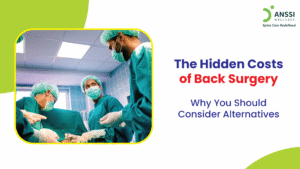Chronic back pain is one of the most common health concerns in the world today. Millions of people, particularly working professionals and older adults, live with persistent discomfort in their spines that affects their daily life, productivity, and overall well-being.
In many cases, surgery is suggested as a solution. However, surgery isn’t always the best choice for managing chronic back pain. Understanding its limitations and exploring safer, non-surgical alternatives can help patients make better, informed decisions for long-term relief.
Understanding Chronic Back Pain
Back pain can arise from several conditions, such as a disc bulge, herniated disc, spinal stenosis, or degenerative disc disease. These issues are often linked to lifestyle factors like poor posture, lack of exercise, or long working hours in a sedentary position.
Chronic pain develops over time as the spine undergoes stress and wear-and-tear. It may start as occasional stiffness but can progress to persistent pain that affects daily movement.
While surgery is often recommended to correct structural issues in the spine, the pain is not always fully eliminated after the surgery.
Limitations of Back Surgery
Back surgery can be effective in certain critical cases, but it comes with significant limitations:
1. Addresses Structure, Not Always the Root Cause
Surgery may fix a visible disc problem, but it does not always resolve the underlying causes of pain, such as muscle weakness, poor spinal alignment, or inflammation.
2. Risk of Complications
Like any major procedure, surgery carries risks including infection, nerve injury, and Failed Back Surgery Syndrome (FBSS), which is a condition where pain persists even after surgery.
3. Recovery Time and Restricted Mobility
Patients often require months of recovery, physical therapy, and activity restrictions after surgery. For professionals, this downtime can be a huge setback.
4. Recurrence of Pain
Even after surgery, back pain can return. In many cases, the condition may reappear in adjacent areas of the spine, leading to repeated interventions.
5. Emotional and Financial Burden
The stress of undergoing surgery, combined with high medical costs, can cause emotional strain and financial difficulties for families.
Because of these limitations, surgery should usually be considered as a last resort.
Non-Surgical Alternatives for Back Pain Relief
Thankfully, many patients can find effective relief through non-surgical approaches that are safe, sustainable, and focused on long-term healing.
Lifestyle Modifications
- Posture correction: Sitting with proper lumbar support and keeping screens at eye level.
- Ergonomic setup: Using supportive chairs/standing desks or adjusting workspace for spinal health.
- Weight management: Reducing extra weight helps lower pressure on spinal discs.
Physiotherapy and Targeted Exercises
Physiotherapists design customised exercise programs to strengthen back muscles, improve flexibility, and support spinal alignment. Consistent exercises such as core strengthening, stretching, and mobility routines can help prevent flare-ups of pain.
Pain Management Therapies
Therapies like heat and cold application, ultrasound therapy, or electrical stimulation are often effective in reducing discomfort and inflammation without the need for invasive procedures.
Non-Surgical Spinal Decompression Treatment
One of the most advanced and effective non-surgical methods available today is Non-Surgical Spinal Decompression Treatment. This procedure is gaining popularity globally for patients with disc bulge, herniated disc, sciatica, and chronic back pain.
How It Works
The treatment uses a specialised machine to gently stretch the spine, creating negative pressure inside the discs. This relieves pressure on compressed nerves, allows herniated or bulging discs to retract, and improves blood and nutrient flow to the spine, supporting natural healing.
Key Benefits
Completely non-invasive: No medicines, injections, or surgery required.
- Promotes healing: Encourages natural recovery of damaged discs.
- Restores mobility: Patients often experience improved flexibility and reduced stiffness.
- Safe and effective: Suitable for most people with no side effects.
- Long-term relief: Unlike temporary painkillers, spinal decompression addresses the underlying cause of pain.
Patients often report significant improvement in pain levels and quality of life after undergoing a recommended course of non-surgical spinal decompression treatment.
About ANSSI:
ANSSI Wellness focuses on improving the quality of life for patients suffering from spinal issues, aiming to provide relief where other conventional treatments have failed. Through advanced Non-Surgical Spinal Decompression Treatment, ANSSI is committed to helping patients avoid surgery and recover in a safe, effective, and compassionate environment.
Connect with ANSSI Wellness on LinkedIn, Instagram, and Facebook for expert guidance.




